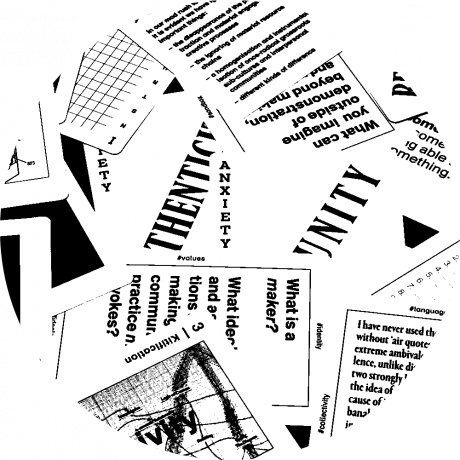An Anxious Game of Cards
An Anxious Game of Cards
The workshop “Unmaking: 5 Anxieties” was conceived as a conversation to retrospectively consider the past ten years of what has been called the “maker movement.” As was noted in other sessions at transmediale, this decade featured the broadening of access and interest in home electronics fabrication, including the dawn of the Arduino microcontroller prototyping platform, the Rep-Rap open-source 3D printer, and the inaugural issue of Make magazine. The rhetoric that has accompanied these developments has been largely utopian and idyllic, purporting that electronics production could supplant existing manufacturing industries, or that 3D printing might replace hardware stores, for example. In reality, though these three initiatives have inched towards that possibility, they have also been bellwethers for other outcomes. Make magazine has solidified control over a branded form of making, culminating with regional Maker Faires; technical innovation from the Rep-Rap has been re-absorbed into the for-profit 3D printers of MakerBot; and control over intellectual property as well as the Arduino name itself is hotly contested.
As belief in the applicability and efficacy of home production, open-source, and sharing has broadened to include hackathons, game jams, and open-data-fuelled civic making weekends, taking stock and beginning to articulate how certain approaches work—or don’t work—within making has become worthwhile. In the “5 Anxieties” workshop, we distributed a deck of cards that contained five “suits” of anxieties. The cards in each suit articulated an aspect of that dimension of making.
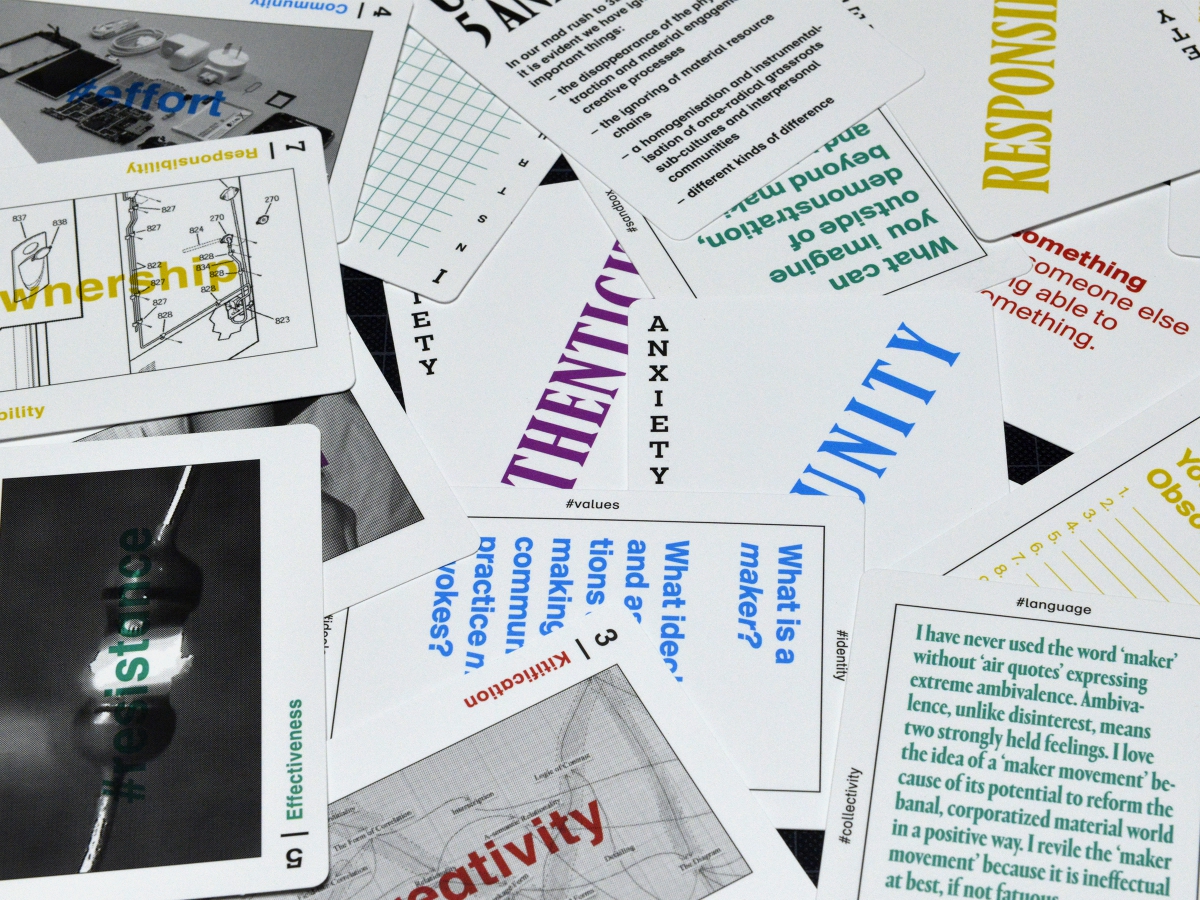
These aspects of making were:
Community: how does making increase or reduce proximities, collectivities, autonomies, sufficiencies, and dependencies?
What is the interplay between grassroots sub-cultures that have been involved in making for a long time, and the more general cultural-economical rise of making, including the becoming mainstream of making or its political appropriation? What kinds of difference are included or excluded within maker communities? How diverse can a community be before it is not a community anymore? What changes when making practices are picked up in contexts beyond maker culture’s specific networks and aesthetics?
Responsibility: does making give us abilities to respond politically, ecologically, economically?
What consequences does the “maker” model have for economic modes of production? What effects does it have on material resource chains? What happens to the artifacts that are made? What effects does the capitalization of making and creativity have on its subcultural practices and political impact?
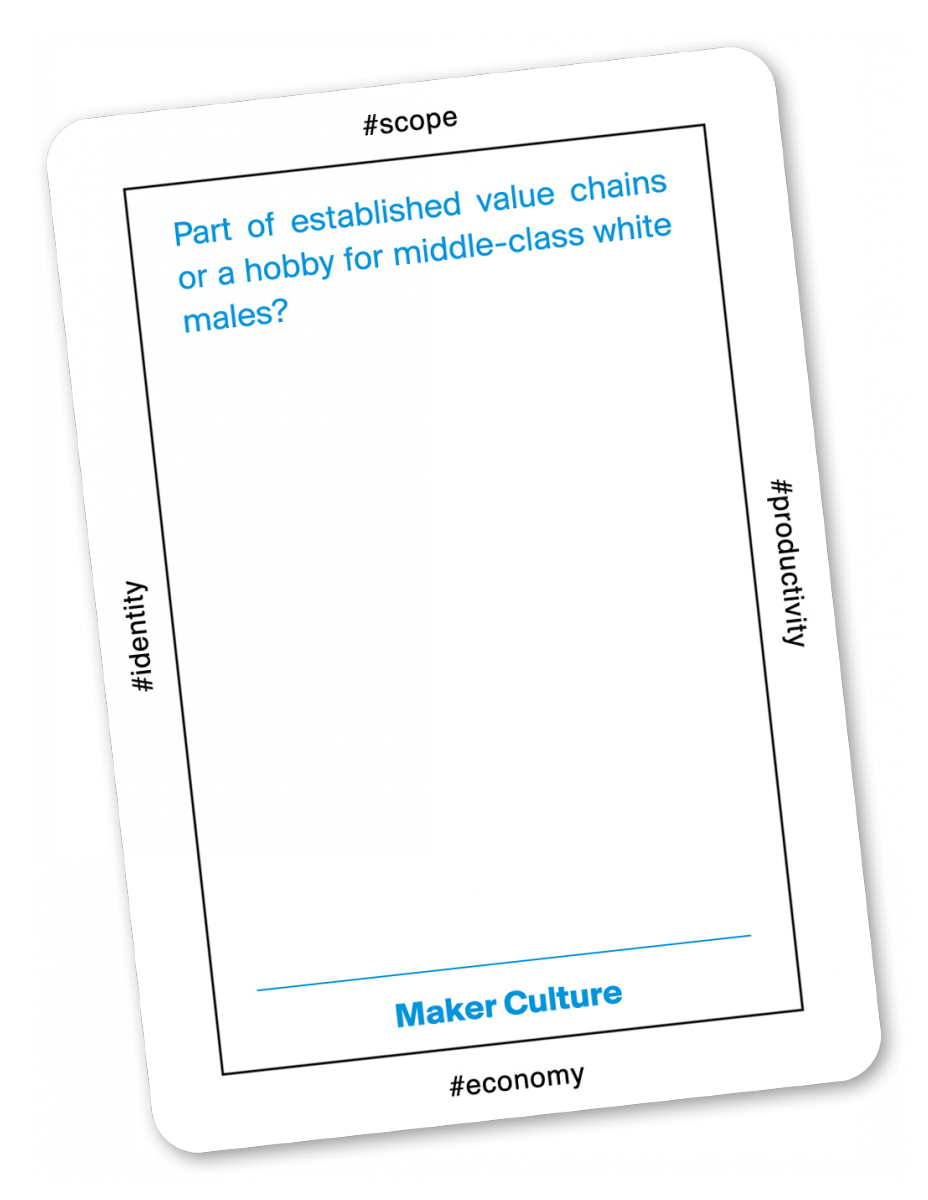
Effectiveness: does making (need to) make a difference?
How can we deal with a spectrum of making contexts ranging from process-oriented personal tinkering to the large-scale goal-oriented manufacturing of useful artifacts? Is making over-fraught with ideological hopes and expectations? Is there too much emphasis on the processes of making within maker culture, celebrating making something but not actually putting it into use? Is making inextricably tied to technological solutionism and futurism?
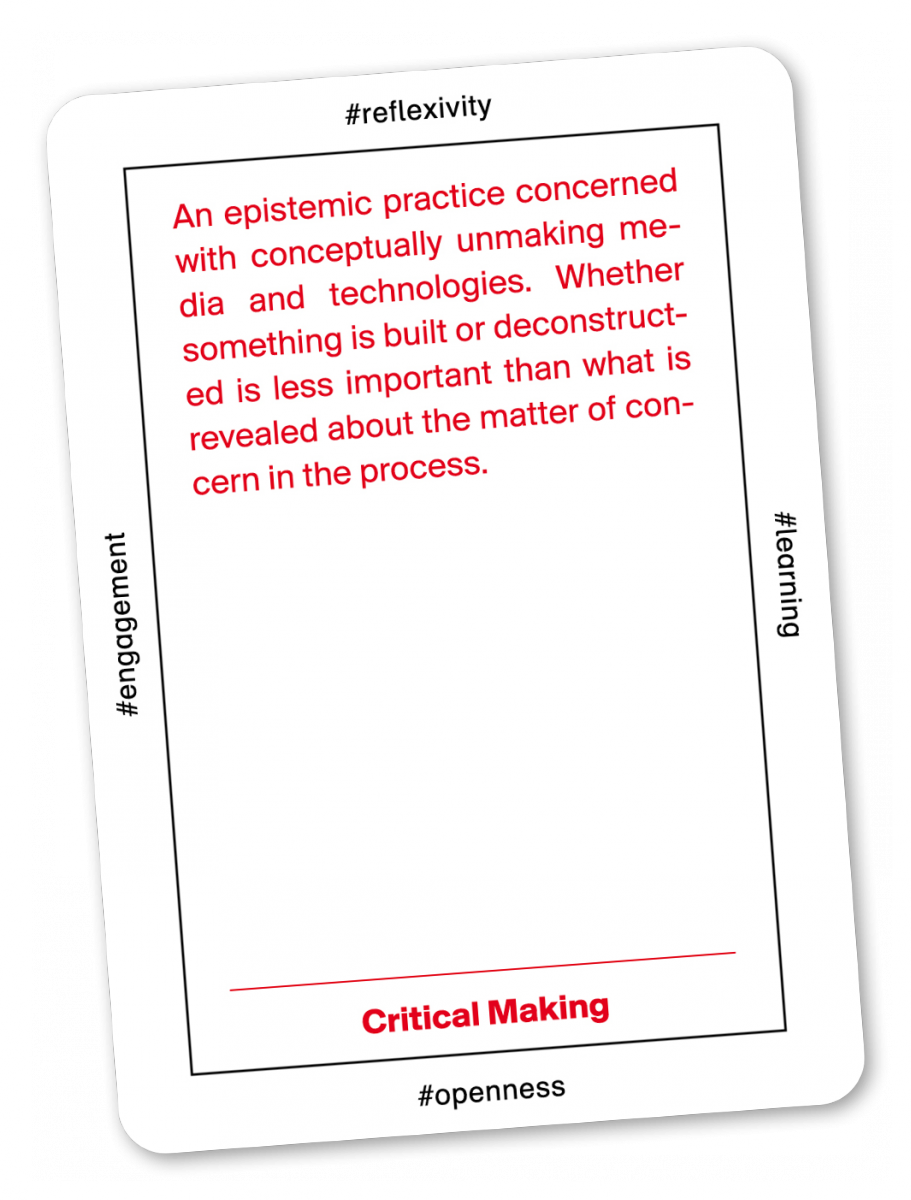
Authenticity: are our experiences of making sincere, legitimate, and genuine?
How is authenticity within maker culture tied to technological knowledge or to long-term involvement? How is authorship of maker artifacts distributed among resources for making, instructions and tutorials, devices, and makers? What are the standards or points of reference for sincerity, legitimacy, or genuineness in this context? Is an ideological attachment to maker culture also leading to fetishism or almost cult-like traits? Does making something automatically imply that one is a maker?

Kitification: how can we think ‘outside the box’ when everything comes in a box?
How is technological culture being reworked into universalized kits that aim to provide prefabricated pathways to solutions for any context? What do kits and systems like Arduino, IDEO cards, or design thinking imply politically, culturally, and epistemologically? Are kits and Baukästen useful tools to learn something about technology, or are they commodifying and promoting a specific take on technology—thereby also limiting possible projects? How are digital practices being packaged into single-serving apps instead of customizable platforms? Is it useful to have an underlying unified system within maker ecologies or are we better off with locally grounded idiosyncratic approaches?
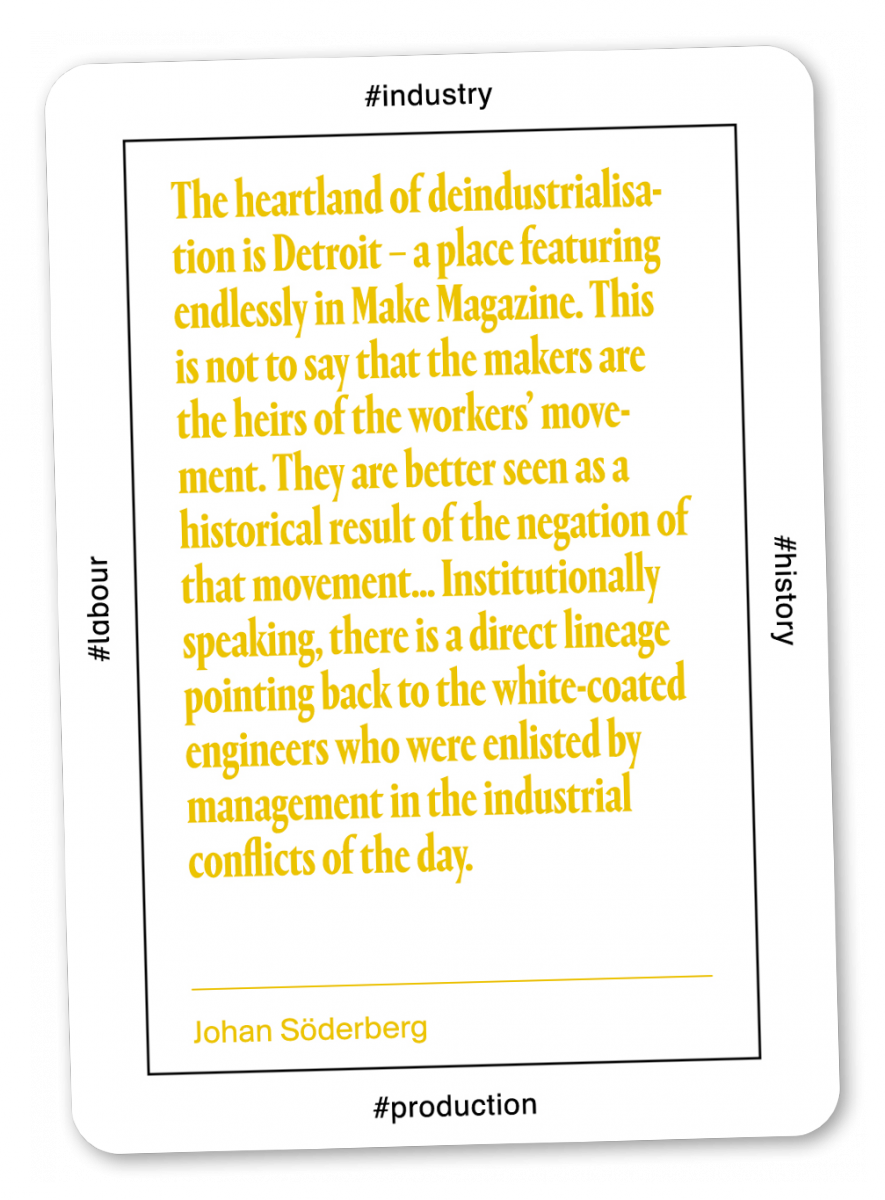
Our workshop involved using the cards to frame a discussion of these anxieties. Participants were introduced to the deck, its suits, and the cards in those suits. We then used the cards to prompt discussions of the anxieties as a meta-narrative in making and related pursuits. To begin, a card was drawn from the deck to offer a specific anxiety that became the topic of conversation. Once that topic had run dry, attendees could use a card to “trump” the one in focus, providing a new conversation prompt.
One prominent theme that emerged from this discussion was the ambiguity of making as a term. Maker culture has long outgrown hobbyist electronics and DIY practices. Even as the political weight of mostly white, mostly well-off, mostly male enthusiasts have imbued the term with both clout and currency, in application the sometimes-frustrating vagueness of making has proved a viable way for other communities to position themselves at the bleeding edge of something with cultural traction.
Far from being exclusively a neoliberal or libertarian practice, the rhetoric of making, of individual production in service to some imagined goal, has been used to motivate hackathons for civic good, to brand “makerspaces” that act as de-facto research and development facilities for addressing on-the-ground issues in Northern Africa, to brand labor unions seeking public support in defending the “right to repair,” and yes, to produce and share bespoke gadgets and baubles among the technically-inclined.
So far, at least, the success of the “maker movement” is not in producing STEM education outcomes, or in upending the capitalist assumptions around production, or in creating a new market for technology companies to sell kits and prototyping equipment to. In the end, the success has been to create a language and grammar to talk about the small-scale production of electronics, akin to similar terms in other craft communities: ”artisanal,” “local,” and “handmade,” for example.
While there was some shared understanding of what characterizes maker culture as a cultural format of practice and milieu, opinions varied depending on the specific case being discussed.

The workshop took place on 7 February 2016.
Kits and manuals provided with them were considered useful tools for learning something about electronics, whereas there was much skepticism about the consumerism and fetishism that have evolved around platforms like Arduino and Raspberry Pi. Clearly the context of learning and doing research through making seemed much less laden with worries than other aspects we touched in our conversation. Making as a practice within the different contexts mentioned above is something different than maker culture or calling oneself a maker. And the sometimes raw and “handmade” aesthetics of maker artifacts seem to be often an arbitrary, superficial feature or a statement of cultural or aesthetic affiliation.
Especially in the politically and socially oriented strands of our discussion the context specificity of maker practices became crucial. It makes a difference whether one is sitting at home and feeling genuinely proud of one’s success in getting some LEDs to blink, or whether one is collaborating in the production of sustainable light sources in an infrastructurally underdeveloped part of the world. In both cases a fundamental belief in technological solutionism might never be overcome. Refraining from affiliating oneself with the rather symbolic and discursive aspects of maker culture could be helpful to avoid some of its pitfalls, although such an affiliation could also be a means to attract public and financial support.
The case of the newly launched repair.org demonstates another interesting strategy. Rooted in the traditional concept of industrial unions, the project reappropriates the language and grammar of making for the purposes of traditional manufacturing jobs as part of its public campaigning strategy—bearing in mind that maker culture rather stems from a middle class hobbyist background.
Ultimately, the tensions that exist within the domain of making are omnipresent. The flexibility and currency that have helped this rhetoric and its underlying set of practices gain prominence have done so at the expense of any central core of practice. So what makes making? Is it ideology without outcome, construction without context? Or is it process and perseverance, community and collaboration? Making is all of these, and while that affords flexibility and leverage it might never develop a cogent core. In being everything, making may not wind up with much to offer.
A collaborative text by:
Critical Media Lab researchers Moritz Greiner-Petter, Johannes Bruder, Shintaro Miyazaki, Felix Gerloff and Jamie Allen, along with collaborative partners Matthias Tarasiewicz and Sophie Wagner from the Vienna-based Research Institute for Arts and Technology, and researcher Tom Jenkins from from the Public Design Workshop at Georgia Tech’s Digital Media program.
